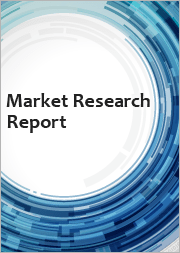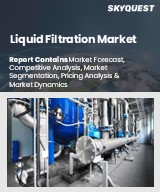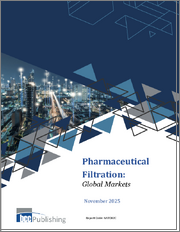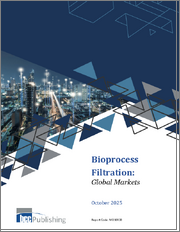
|
시장보고서
상품코드
1808651
전자 여과 시장 : 제품 유형, 카테고리, 미디어 재료, 사이즈, 용도, 최종 이용 산업별 - 세계 예측(2025-2030년)Electronic Filtration Market by Product Type, Category, Media Material, Size, Application, End-User Industry - Global Forecast 2025-2030 |
||||||
전자 여과 시장의 2024년 시장 규모는 101억 2,000만 달러로 평가되었으며, 2025년에는 107억 2,000만 달러, CAGR 6.15%로 성장하여 2030년에는 144억 9,000만 달러에 달할 것으로 예측됩니다.
| 주요 시장 통계 | |
|---|---|
| 기준 연도 2024년 | 101억 2,000만 달러 |
| 추정 연도 2025년 | 107억 2,000만 달러 |
| 예측 연도 2030년 | 144억 9,000만 달러 |
| CAGR(%) | 6.15% |
세계 수요 증가와 끊임없는 기술 혁신 속에서 첨단 산업에서 전자 여과의 중요한 역할이 확립되었습니다.
전자 여과는 점점 더 엄격해지는 환경 규제와 더 높은 업무 효율의 필요성에 대응하기 위해 현대 산업 공정의 최전선에 뛰어들었습니다. 필터 설계 및 재료의 혁신은 전례 없는 수준의 미립자 제거를 가능하게 하여 반도체 제조, 헬스케어, 자동차 생산과 같은 중요한 분야에서 매우 중요한 역할을 하고 있습니다. 생산 라인에서는 기체와 액체의 순도를 그 어느 때보다 세밀하게 관리해야 하기 때문에 전자 여과를 통한 오염물질 제거 능력은 경쟁 우위와 규제적 필요성에 따라 발전하고 있습니다.
진화하는 규제 기준 하에서 전자 여과 기술 및 제조 공정의 파괴적 변화를 주도하는 변혁적 힘에 대해 알아봅니다.
전자 여과의 정세는 기술적 비약적 발전과 환경 규제 강화로 인해 변화의 시기를 맞이하고 있습니다. 최근 나노섬유 제조 및 적층 가공 기술의 발전으로 미세한 입자를 더 높은 효율과 내구성으로 포획하는 새로운 필터 형태가 등장했습니다. 이러한 기술 혁신은 성능 기준을 재정의하고, 낮은 압력 손실과 에너지 사용량을 유지하면서 서브미크론 수준의 오염물질을 포집할 수 있게 해줍니다.
2025년 미국 관세가 전자 필터 부품 공급망과 비용 구조에 미치는 원거리 영향 분석
2025년, 미국은 전자 여과 시스템에 사용되는 주요 원자재와 부품에 대한 일련의 관세 조치를 시행했습니다. 국내 생산을 강화하기 위한 이 조치는 세계 공급망 전체에 연쇄적인 영향을 미쳤습니다. 북미 이외 지역의 공급업체들은 비용 상승에 직면했고, 일부 공급업체들은 가격 변동을 완화하기 위해 물류 네트워크 재구축과 장기 계약 협상에 착수했습니다. 한편, 필터 제조업체는 조달 전략을 다양화하고, 주요 생산 공정을 근해로 이전하고, 국내 철강 및 폴리머 제조업체와 긴밀한 관계를 구축하여 대응했습니다.
전자 여과의 제품 유형, 매체 재료, 크기, 용도 및 최종사용자 산업 동향을 형성하는 종합적인 세분화 동역학에 대한 명확한 이해
제품 유형에 따른 시장 세분화는 에어 필터, 가스 필터, 액체 필터로 나뉘며, 각각 고유한 성능 기준과 최종 사용 수요를 가지고 있습니다. 에어 필터 영역에서는 미크론 이하의 입자를 포집하는 능력으로 알려진 고효율 미립자 에어 필터와 여과의 한계를 뛰어넘는 초저미립자 에어 필터를 구분하고 있습니다. 가스 필터 카테고리에서는 파이프라인에 원활하게 통합되도록 설계된 인라인 솔루션과 중요한 공정 분기점에서 국소 정화를 수행하는 사용 시점 단위(Point-of-Use Unit)를 모두 조사하고 있습니다. 액체 필터에는 다량의 침전물을 제거하는 백 필터, 유량과 유지력의 균형을 맞추는 카트리지 필터, 오염물질 포집에 3차원 구조를 이용하는 뎁스 필터, 분자 수준의 분리를 실현하는 멤브레인 필터 등 다양한 구성이 있습니다.
아메리카, 유럽, 중동 및 아프리카, 아시아태평양의 전자 여과 시장 지역별 개발 및 성장 촉진요인 강조
아메리카의 지역적 역학은 자동차 및 반도체 부문의 강력한 수요가 전자 여과 기술 혁신을 어떻게 촉진하고 있는지를 보여줍니다. 아메리카의 제조업체들은 엄격한 배출 기준과 클린룸 요건을 충족하기 위해 첨단 미디어 재료에 투자하고 있습니다. 한편, 라틴아메리카에서는 산업과 지자체 모두의 요구를 충족시키기 위해 멤브레인 기술을 활용한 정수 시스템에 집중하고 있습니다.
주요 시장 플레이어 프로파일링 세계 전자 여과 산업 환경을 재구성하는 전략적 파트너십 혁신과 경쟁 환경의 재구성
주요 여과 공급업체들은 전략적 파트너십, 표적화된 인수, 재료 과학 분야의 기술 혁신의 조합을 통해 업계를 형성하고 있습니다. 필터 제조업체와 세라믹 미디어 제조업체와의 공동 연구 개발 계약은 세라믹의 내구성과 폴리머 멤브레인의 정밀도를 결합한 하이브리드 필터를 탄생시켰습니다. 또한 일부 전통 제조업체는 나노 섬유 기술의 틈새 전문가를 인수하여 제품 포트폴리오를 확장하고 클린 룸의 새로운 표준에 적합한 초경량 및 고효율 필터를 포함하도록 제품 포트폴리오를 확장했습니다.
전자 여과 분야의 기술 발전, 규제 변화, 시장 변동에 대응하는 업계 리더를 강화하는 전략적 지침과 실행 가능한 이니셔티브를 제공합니다.
업계 리더들은 유지보수 필요성을 예측하고 가동 시간을 최적화하기 위해 센서 네트워크와 클라우드 분석을 결합한 디지털 여과 플랫폼에 우선적으로 투자해야 합니다. 예측 알고리즘을 도입함으로써 기업은 계획되지 않은 다운타임을 줄이고, 필터의 수명주기를 연장하며, 궁극적으로 총소유비용을 절감할 수 있습니다. 또한, 원자재 혁신가, 특히 첨단 고분자 복합재 및 세라믹 혼합물을 개발하는 회사와의 제휴는 효율성과 내구성에서 경쟁력을 유지하기 위해 필수적입니다.
전자 여과 시장 분석 및 인사이트에서 데이터의 무결성과 종합적인 조사 대상을 보장하기 위해 채택된 강력한 연구 방법론의 개요를 설명합니다.
본 분석은 1차 조사와 2차 조사 방법을 엄격하게 결합하여 포괄적이고 신뢰할 수 있는 인사이트를 얻었습니다. 1차 조사는 여러 지역의 업계 임원, 여과 엔지니어, 조달 전문가, 규제 전문가와의 심층 인터뷰로 구성되었습니다. 이러한 대화를 통해 혁신 파이프라인, 비용 압박, 새로운 최종 용도 요구사항에 대한 직접적인 견해를 얻을 수 있었습니다. 2차 조사에서는 기술 논문, 특허 출원, 산업 백서, 정부 규제 등을 체계적으로 검토하여 과거 동향을 파악하고 주요 기술 혁신 사례를 파악했습니다.
종합적인 분석을 통해 얻은 주요 발견과 핵심 요점을 통합하여 전자 여과 기술 및 시장의 미래 방향에 대한 종합적인 전망을 제공합니다.
이번 Executive Summary에서는 관세 제도의 파괴적 영향부터 첨단 소재와 디지털 통합으로 인한 변화의 가능성까지 오늘날의 전자 여과 시장의 다면적인 특성을 설명했습니다. 종합적인 세분화의 역학, 지역적 차이, 경쟁 전략을 검토하면 일관된 이야기가 나옵니다.
목차
제1장 서문
제2장 조사 방법
제3장 주요 요약
제4장 시장 개요
제5장 시장 역학
제6장 시장 인사이트
- Porter's Five Forces 분석
- PESTEL 분석
제7장 미국 관세의 누적 영향 2025
제8장 전자 여과 시장 : 제품 유형별
- 에어 필터
- HEPA 필터
- ULPA 필터
- 가스 필터
- 인라인
- 사용 장소
- 액체 필터
- 백 필터
- 카트리지 필터
- 심도 필터
- 멤브레인 필터
제9장 전자 여과 시장 : 카테고리별
- 올 패스 필터
- 밴드 패스 필터
- 밴드 스톱 필터
- 하이 패스 필터
- 로우 패스 필터
제10장 전자 여과 시장 : 미디어 재료별
- 세라믹
- 유리섬유
- 금속
- 니켈
- 스테인리스강
- 폴리머
- 폴리프로필렌
- 폴리테트라플루오로에틸렌
제11장 전자 여과 시장 : 사이즈별
- 매크로
- 마이크로
제12장 전자 여과 시장 : 용도별
- 클린룸 환경
- 가스 공급 시스템
- 포토리소그래피
- 물 정화
- 웨트 에칭과 세정 프로세스
제13장 전자 여과 시장 : 최종 이용 산업별
- 자동차
- 일렉트로닉스
- 헬스케어
- 반도체
- 통신
제14장 아메리카의 전자 여과 시장
- 미국
- 캐나다
- 멕시코
- 브라질
- 아르헨티나
제15장 유럽, 중동 및 아프리카의 전자 여과 시장
- 영국
- 독일
- 프랑스
- 러시아
- 이탈리아
- 스페인
- 아랍에미리트
- 사우디아라비아
- 남아프리카공화국
- 덴마크
- 네덜란드
- 카타르
- 핀란드
- 스웨덴
- 나이지리아
- 이집트
- 튀르키예
- 이스라엘
- 노르웨이
- 폴란드
- 스위스
제16장 아시아태평양의 전자 여과 시장
- 중국
- 인도
- 일본
- 호주
- 한국
- 인도네시아
- 태국
- 필리핀
- 말레이시아
- 싱가포르
- 베트남
- 대만
제17장 경쟁 구도
- 시장 점유율 분석, 2024
- FPNV 포지셔닝 매트릭스, 2024
- 경쟁 분석
- 3M Company
- AAir Purification Systems
- Air Purification, Inc.
- Alfa Chemistry
- American Air Filter International by Daikin Industries, Ltd.
- Camfil AB
- Cobetter Filtration Equipment Co.,Ltd
- D&D Filtration
- Donaldson Company, Inc.
- Entegris, Inc.
- Evoqua Water Technologies LLC
- Fil-Trek
- Filtersource.com, Inc.
- Freudenberg Filtration Technologies GmbH & Co. KG
- Global Filter
- Graver Technologies
- Koch Filter
- Lenzing AG
- MANN+HUMMEL International GmbH & Co. KG
- Mott Corporation
- Pall Corporation
- Parker Hannifin Corporation
- Porvair Filtration Group Ltd.
- Valin Corporation
- W. L. Gore & Associates, Inc.
제18장 리서치 AI
제19장 리서치 통계
제20장 리서치 컨택트
제21장 리서치 기사
제22장 부록
KSM 25.09.23The Electronic Filtration Market was valued at USD 10.12 billion in 2024 and is projected to grow to USD 10.72 billion in 2025, with a CAGR of 6.15%, reaching USD 14.49 billion by 2030.
| KEY MARKET STATISTICS | |
|---|---|
| Base Year [2024] | USD 10.12 billion |
| Estimated Year [2025] | USD 10.72 billion |
| Forecast Year [2030] | USD 14.49 billion |
| CAGR (%) | 6.15% |
Establishing the Critical Role of Electronic Filtration in Advanced Industries Amidst Heightened Global Demand and Continuous Technological Innovation
Electronic filtration has moved to the forefront of modern industrial processes as organizations grapple with increasingly stringent environmental regulations and the need for higher operational efficiency. Innovations in filter design and materials have enabled unprecedented levels of particulate removal, playing a pivotal role in critical sectors such as semiconductor manufacturing, healthcare, and automotive production. As production lines demand ever-finer control over gas and liquid purity, the ability to remove contaminants through electronic filtration has evolved into both a competitive advantage and a regulatory necessity.
Moreover, the convergence of digital monitoring and advanced membrane materials underscores a broader shift toward smart filtration systems. Sensors integrated within filter housings now provide real-time performance data, enabling proactive maintenance and minimizing costly downtime. In response, companies are forging partnerships across the value chain to accelerate the development of next-generation filters that deliver enhanced reliability, reduced energy consumption, and lower total cost of ownership. This introduction frames the context in which electronic filtration emerges not merely as a support technology but as a strategic enabler for organizations pursuing operational excellence and regulatory compliance.
Uncovering the Transformational Forces Driving Disruptive Shifts in Electronic Filtration Technology and Manufacturing Processes Under Evolving Regulatory Standards
The landscape of electronic filtration is undergoing transformative shifts driven by a combination of technological breakthroughs and escalating environmental mandates. Recent advancements in nanofiber production and additive manufacturing techniques have unlocked novel filter geometries that capture microscopic particles with greater efficiency and durability. Such innovations are redefining performance benchmarks, enabling filters to trap contaminants at the submicron level while maintaining low pressure drops and energy usage.
Simultaneously, regulatory bodies around the globe have tightened permissible emission levels, compelling manufacturers to adopt advanced filtration solutions. Emerging markets and mature economies alike face pressure to reduce air and water pollutants, leading to a surge in demand for high-efficiency particulate air filters and membrane-based technologies. Furthermore, the intersection of the Internet of Things and filtration assets has accelerated the shift toward predictive maintenance frameworks. By harnessing embedded sensors and cloud-based analytics, operators can forecast maintenance cycles, optimize filter lifespans, and prevent performance degradation. Collectively, these forces are driving disruptive shifts in production practices, supply chain structures, and competitive positioning across the electronic filtration market.
Analyzing the Far Reaching Consequences of United States Tariffs Implemented in 2025 on Electronic Filtration Components Supply Chains and Cost Structures
In 2025, the United States implemented a series of tariffs targeting key raw materials and components used in electronic filtration systems. These measures, intended to bolster domestic production, have triggered a cascade of effects throughout global supply chains. Suppliers located outside North America faced increased costs, prompting some to reconfigure their logistics networks or negotiate long-term contracts to mitigate price volatility. Meanwhile, filter manufacturers responded by diversifying their sourcing strategies, nearshoring critical production steps and forging closer ties with domestic steel and polymer producers.
The imposition of tariffs also accelerated a broader trend toward vertical integration, as companies sought to reclaim margin lost to rising input costs. Some leaders chose to invest in in-house manufacturing capabilities for high-grade filter media, reducing exposure to external price fluctuations. Others engaged in strategic partnerships to secure prioritized access to advanced ceramics and specialty polymers. As a result, the filtration ecosystem has shifted from a fragmented network of independent suppliers to a more consolidated environment where a handful of integrated players exert greater influence over pricing and availability. These tariff-driven realignments continue to shape cost structures and competitive dynamics across the industry.
Revealing Comprehensive Segmentation Dynamics Shaping Product Type Category Media Material Size Application and End User Industry Trends in Electronic Filtration
The market's segmentation based on product type spans air filters, gas filters, and liquid filters, each with its own performance criteria and end-use demands. Within the air filter domain, the study differentiates high efficiency particulate air filters, known for their capacity to trap sub-micron particles, from ultra low particulate air filters, which push filtration boundaries even further. The gas filter category examines both inline solutions designed to integrate seamlessly into pipelines and point-of-use units that deliver localized purification at critical process junctures. Liquid filters encompass a broad range of configurations, including bag filters for bulk sediment removal, cartridge filters that balance flow and retention, depth filters that rely on three-dimensional structures for contaminant capture, and membrane filters that achieve molecular-level separation.
Highlighting Distinct Regional Developments and Growth Drivers Across the Americas Europe Middle East Africa and Asia Pacific Electronic Filtration Markets
Regional dynamics in the Americas illustrate how strong demand from the automotive and semiconductor sectors is driving innovation in electronic filtration. Manufacturers in North America and South America are investing in advanced media materials to meet stringent emissions standards and cleanroom requirements. Meanwhile, initiatives in Latin America focus on water purification systems that leverage membrane technologies to address both industrial and municipal needs.
Across Europe, the Middle East, and Africa, evolving environmental regulations have spurred demand for high-performance filters in industrial and commercial applications. Companies in Western Europe lead in developing ceramic media filters that resist aggressive chemicals, while emerging economies in the Middle East and Africa prioritize cost-effective solutions to support oil and gas operations. In Asia Pacific, the region's role as a manufacturing hub for electronic components and semiconductors has created one of the largest markets for filtration systems. Governments and private entities alike are funding research into polymer-based filters and scalable production methods to bolster local supply chains and reduce reliance on imports.
Profiling Leading Market Players Strategic Partnerships Innovations and Competitive Strategies That Are Reshaping the Electronic Filtration Industry Landscape Worldwide
Leading filtration providers are shaping the industry through a combination of strategic partnerships, targeted acquisitions, and innovation in materials science. Collaborative R&D agreements between filter manufacturers and ceramic media producers have given rise to hybrid filters that marry the durability of ceramics with the precision of polymer membranes. Several established players have also acquired niche specialists in nanofiber technology, expanding their product portfolios to include ultralight, high-efficiency filters suitable for emerging cleanroom standards.
Competitive strategies are increasingly centered on offering end-to-end filtration solutions, bundling hardware with digital monitoring services. Providers are integrating real-time analytics platforms with proprietary software to deliver performance insights and predictive maintenance alerts. This shift toward servitization not only enhances customer loyalty but also creates recurring revenue streams. In parallel, some companies have invested in geographically distributed manufacturing facilities to circumvent tariff impacts and ensure rapid delivery. By aligning production footprints with global demand hotspots, these organizations maintain supply chain resilience and accelerate time-to-market.
Delivering Strategic Guidance and Actionable Initiatives to Empower Industry Leaders Navigating Technological Advances Regulatory Changes and Market Volatility in Electronic Filtration
Industry leaders must prioritize investment in digital filtration platforms that combine sensor networks with cloud analytics to anticipate maintenance needs and optimize operational uptime. By deploying predictive algorithms, organizations can reduce unplanned downtime and extend filter lifecycles, ultimately lowering total cost of ownership. Additionally, forging alliances with raw material innovators-particularly those developing advanced polymer composites and ceramic blends-will be essential to maintaining a competitive edge in efficiency and durability.
Supply chain diversification should remain a strategic imperative. Companies can mitigate geopolitical risks by balancing nearshore production with established offshore relationships, negotiating framework agreements that include cost-stabilization clauses and flexible order volumes. At the same time, aligning product roadmaps with evolving regulatory landscapes-such as anticipated revisions to air quality standards and emerging water purity mandates-will enable faster go-to-market approval and reduce compliance hurdles. Finally, cultivating service-based offerings around filtration performance audits and asset management will unlock new revenue streams while reinforcing long-term client partnerships.
Outlining Robust Research Methodologies Employed to Ensure Data Integrity Validity and Comprehensive Coverage in the Electronic Filtration Market Analysis and Insights
This analysis draws on a rigorous combination of primary and secondary research methodologies to ensure comprehensive and reliable insights. Primary research comprised in-depth interviews with industry executives, filtration engineers, procurement specialists, and regulatory experts across multiple regions. These conversations provided firsthand perspectives on innovation pipelines, cost pressures, and emerging end-use requirements. Secondary research included a systematic review of technical papers, patent filings, industry white papers, and government regulations to map historical trends and identify key technological breakthroughs.
Data triangulation techniques were applied to reconcile divergent information sources and validate findings. Quantitative data from trade associations and customs databases were cross-checked against company financial disclosures and investment reports. A panel of subject matter experts further reviewed draft analyses to confirm assumptions and calibrate qualitative interpretations. The result is a holistic framework that integrates market segmentation, competitive landscaping, regulatory mapping, and technological assessment to support strategic decision-making in electronic filtration.
Synthesizing Key Findings and Core Takeaways From Comprehensive Analysis to Provide a Cohesive Perspective on Future Directions in Electronic Filtration Technologies and Markets
This executive summary has illustrated the multifaceted nature of today's electronic filtration market, from the disruptive influences of tariff regimes to the transformative potential of advanced materials and digital integration. By examining comprehensive segmentation dynamics, regional variations, and competitive strategies, a coherent narrative emerges: success hinges on adaptability, collaboration, and a commitment to continuous innovation.
As environmental regulations tighten and end-use industries demand ever higher levels of purity and reliability, stakeholders must align their strategic priorities with technological advancements and shifting supply chain paradigms. The interplay of regional regulatory frameworks, tariff impacts, and industry consolidation underscores the importance of proactive decision-making. Ultimately, those organizations that combine robust R&D investment with agile operational execution will shape the future trajectory of electronic filtration technologies and capture the greatest value from a rapidly evolving market.
Table of Contents
1. Preface
- 1.1. Objectives of the Study
- 1.2. Market Segmentation & Coverage
- 1.3. Years Considered for the Study
- 1.4. Currency & Pricing
- 1.5. Language
- 1.6. Stakeholders
2. Research Methodology
- 2.1. Define: Research Objective
- 2.2. Determine: Research Design
- 2.3. Prepare: Research Instrument
- 2.4. Collect: Data Source
- 2.5. Analyze: Data Interpretation
- 2.6. Formulate: Data Verification
- 2.7. Publish: Research Report
- 2.8. Repeat: Report Update
3. Executive Summary
4. Market Overview
- 4.1. Introduction
- 4.2. Market Sizing & Forecasting
5. Market Dynamics
- 5.1. Growing demand for compact and high-efficiency electronic filtration systems
- 5.2. Increasing adoption of advanced filtration media for enhanced electronic component protection
- 5.3. Rising focus on sustainable and eco-friendly filtration technologies in electronics
- 5.4. Integration of smart filtration solutions with IoT for real-time monitoring
- 5.5. Expansion of filtration systems in electric vehicles to improve battery performance
- 5.6. Advancements in nanotechnology driving innovation in electronic filtration materials
- 5.7. Regulatory emphasis on reducing electronic waste through improved filtration standards
- 5.8. Rising use of HEPA and ULPA filters in sensitive electronic manufacturing environments
- 5.9. Development of customized filtration solutions to address specific electronic device needs
- 5.10. Increasing investment in R&D for noise and interference reduction in electronic filters
6. Market Insights
- 6.1. Porter's Five Forces Analysis
- 6.2. PESTLE Analysis
7. Cumulative Impact of United States Tariffs 2025
8. Electronic Filtration Market, by Product Type
- 8.1. Introduction
- 8.2. Air Filter
- 8.2.1. HEPA Filters
- 8.2.2. ULPA Filters
- 8.3. Gas Filter
- 8.3.1. Inline
- 8.3.2. Point-of-Use
- 8.4. Liquid Filter
- 8.4.1. Bag Filters
- 8.4.2. Cartridge Filters
- 8.4.3. Depth Filters
- 8.4.4. Membrane Filters
9. Electronic Filtration Market, by Category
- 9.1. Introduction
- 9.2. All-Pass Filters
- 9.3. Band-Pass Filters
- 9.4. Band-Stop Filters
- 9.5. High-Pass Filters
- 9.6. Low-Pass Filters
10. Electronic Filtration Market, by Media Material
- 10.1. Introduction
- 10.2. Ceramic
- 10.3. Glass Fiber
- 10.4. Metal
- 10.4.1. Nickel
- 10.4.2. Stainless Steel
- 10.5. Polymer
- 10.5.1. Polypropylene
- 10.5.2. Polytetrafluoroethylene
11. Electronic Filtration Market, by Size
- 11.1. Introduction
- 11.2. Macro
- 11.3. Micro
12. Electronic Filtration Market, by Application
- 12.1. Introduction
- 12.2. Cleanroom Environments
- 12.3. Gas Delivery Systems
- 12.4. Photolithography
- 12.5. Water Purification
- 12.6. Wet Etching & Cleaning Processes
13. Electronic Filtration Market, by End-User Industry
- 13.1. Introduction
- 13.2. Automotive
- 13.3. Electronics
- 13.4. Healthcare
- 13.5. Semiconductors
- 13.6. Telecommunication
14. Americas Electronic Filtration Market
- 14.1. Introduction
- 14.2. United States
- 14.3. Canada
- 14.4. Mexico
- 14.5. Brazil
- 14.6. Argentina
15. Europe, Middle East & Africa Electronic Filtration Market
- 15.1. Introduction
- 15.2. United Kingdom
- 15.3. Germany
- 15.4. France
- 15.5. Russia
- 15.6. Italy
- 15.7. Spain
- 15.8. United Arab Emirates
- 15.9. Saudi Arabia
- 15.10. South Africa
- 15.11. Denmark
- 15.12. Netherlands
- 15.13. Qatar
- 15.14. Finland
- 15.15. Sweden
- 15.16. Nigeria
- 15.17. Egypt
- 15.18. Turkey
- 15.19. Israel
- 15.20. Norway
- 15.21. Poland
- 15.22. Switzerland
16. Asia-Pacific Electronic Filtration Market
- 16.1. Introduction
- 16.2. China
- 16.3. India
- 16.4. Japan
- 16.5. Australia
- 16.6. South Korea
- 16.7. Indonesia
- 16.8. Thailand
- 16.9. Philippines
- 16.10. Malaysia
- 16.11. Singapore
- 16.12. Vietnam
- 16.13. Taiwan
17. Competitive Landscape
- 17.1. Market Share Analysis, 2024
- 17.2. FPNV Positioning Matrix, 2024
- 17.3. Competitive Analysis
- 17.3.1. 3M Company
- 17.3.2. AAir Purification Systems
- 17.3.3. Air Purification, Inc.
- 17.3.4. Alfa Chemistry
- 17.3.5. American Air Filter International by Daikin Industries, Ltd.
- 17.3.6. Camfil AB
- 17.3.7. Cobetter Filtration Equipment Co.,Ltd
- 17.3.8. D&D Filtration
- 17.3.9. Donaldson Company, Inc.
- 17.3.10. Entegris, Inc.
- 17.3.11. Evoqua Water Technologies LLC
- 17.3.12. Fil-Trek
- 17.3.13. Filtersource.com, Inc.
- 17.3.14. Freudenberg Filtration Technologies GmbH & Co. KG
- 17.3.15. Global Filter
- 17.3.16. Graver Technologies
- 17.3.17. Koch Filter
- 17.3.18. Lenzing AG
- 17.3.19. MANN+HUMMEL International GmbH & Co. KG
- 17.3.20. Mott Corporation
- 17.3.21. Pall Corporation
- 17.3.22. Parker Hannifin Corporation
- 17.3.23. Porvair Filtration Group Ltd.
- 17.3.24. Valin Corporation
- 17.3.25. W. L. Gore & Associates, Inc.






